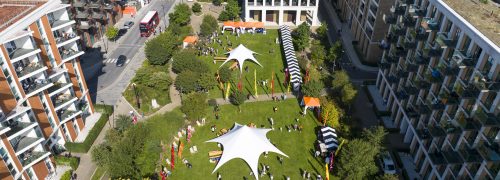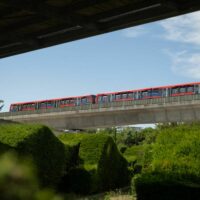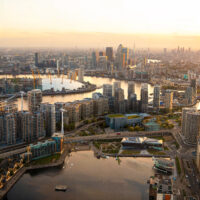
Regeneration news
Royal Wharf: a model for modern urban living
Royal Wharf in the Royal Docks is more than a housing development - it’s a thriving community of 10,000 residents with shops, cafes, a school, businesses, and even its own football club. It stands as a model for how large-scale developments can meet the urgent need for housing while fostering vibrant, sustainable neighbourhoods.
Developed by Ballymore, Royal Wharf transformed a once-barren 40-acre site on the River Thames into a bustling new town. “We saw this as a massive opportunity to create a new town,” says John Mulryan, Ballymore’s Managing Director. “We built a high street, a school, shops, and businesses - all in a place that was previously empty.”
Creating homes was only part of the vision. “It’s about building infrastructure, community, and facilities, making it more than just a housing estate,” explains Glen Howells, Director of architect Howells, the master planner behind the development.
Royal Wharf now boasts around 4,000 homes, green spaces, a community center, a dentist, pharmacy, and Royal Wharf Pier - London’s longest riverboat terminal and the newest stop on the Uber by Thames Clippers service. Remarkably, all this was completed in just six years, enabling a strong, close-knit community to form quickly.
Residents and local business owners agree.
“A significant value we hold is involving our school in the community and the community in our school,” says Linda-May Bingham, Executive Head Teacher at Royal Wharf Primary School. “There’s a strong sense of community spirit here - it’s a vibrant, positive place for families.”
Nicola Micah, owner of Little Hudson Café, shares a similar sentiment. “The area has a great community spirit, especially now that more shops and local businesses have opened up.”
This sense of belonging extends beyond the amenities, thanks to activities organised by the West Silvertown Foundation, which has a center at Royal Wharf. “There’s always something going on and plenty of opportunities to meet people and make great friends,” says new resident Chandrika.
Residents describe Royal Wharf as friendly and diverse. “There are lots of young families and couples with dogs - everyone’s really approachable,” says resident Jo. “It’s not like other places where you don’t know your neighbours,” adds resident Jonnie. “We’ve got friends more than neighbours.”
The community spirit is also fuelled by passionate locals like Vito Monteiro, who founded Royal Wharf FC to bring people together through football. The club’s under-7s team even won a trophy in the Echo Junior League last year.
A Blueprint for Future Housing
As the government seeks to accelerate the delivery of new homes, Royal Wharf demonstrates what’s possible when investment and vision align. Ballymore’s Managing Director, John Mulryan, sees a clear path forward: “If we want the private sector to build more homes in London, we need an environment that encourages investment.”
Royal Wharf was funded without public money, attracting international investment from Singaporean development partner Oxley. “They could have invested anywhere in the world but chose London residential,” explains Mulryan. “That was a positive outcome for the city and for the 10,000 people who now call this home.”
Mulryan believes similar projects can succeed if housing and fiscal policies are designed to encourage long-term investment. “We need to see that type of investment as a good thing for our city,” he says.


